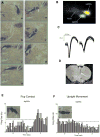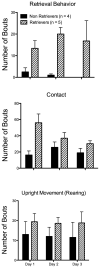Firing patterns of maternal rat prelimbic neurons during spontaneous contact with pups
- PMID: 22643133
- PMCID: PMC3525960
- DOI: 10.1016/j.brainresbull.2012.05.012
Firing patterns of maternal rat prelimbic neurons during spontaneous contact with pups
Abstract
Extracellular single unit activity was recorded from medial prefrontal cortex (mPFC) of postpartum dams over the course of 3 days while they engaged in spontaneous pup-directed behaviors and non-specific exploratory behavior. Out of 109 units identified over the course of the experiment, 15 units were observed to be pup-responsive and 15 increased their discharge rates non-specifically while not attending to pups. An association between neuronal activity and typical maternal behaviors (e.g., retrieval, pup-grooming, nursing) was not observed. Instead, brief bouts of snout contact with pups were accompanied by phasic increases and decreases in spike rates. The observed pup contact responsive cells might play a role in processing of sensory feedback from pups or the transmission of modulatory output to other subcortical maternal brain areas.
Copyright © 2012 Elsevier Inc. All rights reserved.
Figures






Similar articles
-
Inactivation or inhibition of neuronal activity in the medial prefrontal cortex largely reduces pup retrieval and grouping in maternal rats.Brain Res. 2010 Apr 14;1325:77-88. doi: 10.1016/j.brainres.2010.02.027. Epub 2010 Feb 12. Brain Res. 2010. PMID: 20156425 Free PMC article.
-
Variations in nucleus accumbens dopamine associated with individual differences in maternal behavior in the rat.J Neurosci. 2004 Apr 28;24(17):4113-23. doi: 10.1523/JNEUROSCI.5322-03.2004. J Neurosci. 2004. PMID: 15115806 Free PMC article.
-
Medial prefrontal cortex lesions in the female rat affect sexual and maternal behavior and their sequential organization.Behav Neurosci. 2007 Jun;121(3):515-26. doi: 10.1037/0735-7044.121.3.515. Behav Neurosci. 2007. PMID: 17592942
-
Current models and future directions for understanding the neural circuitries of maternal behaviors in rodents.Behav Cogn Neurosci Rev. 2005 Jun;4(2):119-35. doi: 10.1177/1534582305281086. Behav Cogn Neurosci Rev. 2005. PMID: 16251728 Review.
-
Oxytocin links mothering received, mothering bestowed and adult stress responses.Stress. 2002 Dec;5(4):259-67. doi: 10.1080/1025389021000037586. Stress. 2002. PMID: 12475730 Review.
Cited by
-
Postpartum State, but Not Maternal Caregiving or Level of Anxiety, Increases Medial Prefrontal Cortex GAD65 and vGAT in Female Rats.Front Glob Womens Health. 2022 Feb 8;2:746518. doi: 10.3389/fgwh.2021.746518. eCollection 2021. Front Glob Womens Health. 2022. PMID: 35211693 Free PMC article.
-
Brain Reward Pathway Dysfunction in Maternal Depression and Addiction: A Present and Future Transgenerational Risk.J Reward Defic Syndr. 2015;1(3):105-116. doi: 10.17756/jrds.2015-017. Epub 2015 Oct 30. J Reward Defic Syndr. 2015. PMID: 27617302 Free PMC article.
-
Common and divergent psychobiological mechanisms underlying maternal behaviors in non-human and human mammals.Horm Behav. 2015 Jul;73:156-85. doi: 10.1016/j.yhbeh.2015.06.011. Epub 2015 Jun 27. Horm Behav. 2015. PMID: 26122301 Free PMC article. Review.
-
PVN-mPFC OT projections modulate pup-directed pup care or attacking in virgin mandarin voles.Elife. 2024 Oct 16;13:RP96543. doi: 10.7554/eLife.96543. Elife. 2024. PMID: 39412843 Free PMC article.
-
Oxytocin in the medial prefrontal cortex regulates maternal care, maternal aggression and anxiety during the postpartum period.Front Behav Neurosci. 2014 Aug 6;8:258. doi: 10.3389/fnbeh.2014.00258. eCollection 2014. Front Behav Neurosci. 2014. PMID: 25147513 Free PMC article.
References
-
- Afonso VM, Sison M, Lovic V, Fleming AS. Medial prefrontal cortex lesions in the female rat affect sexual and maternal behavior and their sequential organization. Behav Neurosci. 2007;121:515–26. - PubMed
-
- Bartels A, Zeki S. The neural correlates of maternal and romantic love. Neuroimage. 2004;21:1155–1166. - PubMed
-
- Berendse HW, Galis-de Graaf Y, Groenewegen HJ. Topographical organization and relationship with ventral striatal compartments of prefrontal corticostriatal projections in the rat. J Comp Neurol. 1992;316:314–47. - PubMed
-
- Beyer CE, Steketee JD. Dopamine depletion in the medial prefrontal cortex induces sensitized-like behavioral and neurochemical responses to cocaine. Brain Res. 1999;833:133–41. - PubMed
Publication types
MeSH terms
Grants and funding
LinkOut - more resources
Full Text Sources

